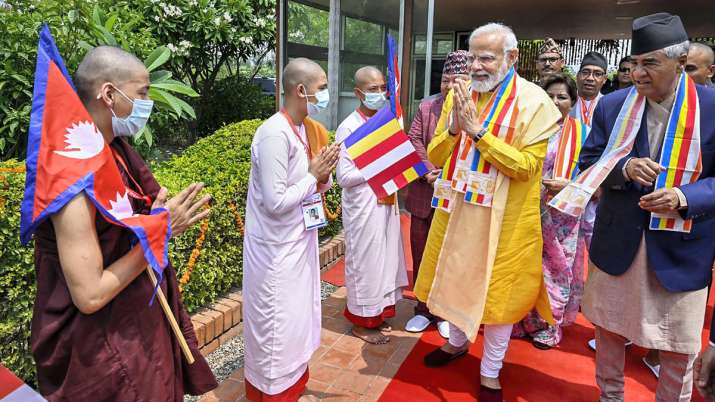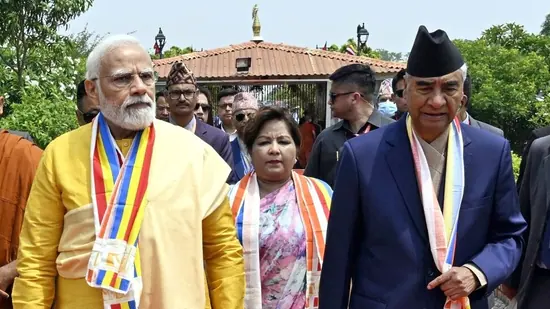On his first official visit to the birthplace of the Buddha, Prime Minister Narendra Modi commemorated Buddha Purnima by laying the foundation stone of a Buddhist cultural and heritage centre in Lumbini, Nepal – the first of its kind in the country.

Modi went on to say that the two countries of “Buddha’s birth and enlightenment have a commitment to work together for the whole humanity” — and that India-Nepal ties are “as ancient as the ocean and as stable as the Himalayas.”
“Amid the type of global crisis that is happening now, the growing and stronger friendship between India and Nepal will work for the good of all mankind.” “Our devotion to Lord Buddha bonds us together and makes us members of one family,” Modi added, alluding to Nepal and India as the “birthplace and enlightenment” of Buddha.
“The spirit of the birthplace of Lord Buddha creates a distinct impression. “I was pleased to observe that the Mahabodhi sapling I gave to this location in 2014 has grown into a tree,” Modi added. He was alluding to his first trip overseas after becoming Prime Minister, when he sent a tree from Bodh Gaya as a gift.
The Prime Minister was speaking to a crowd during the laying of the foundation stone for the India International Centre for Buddhist Culture and Heritage. It is India’s first Buddhist centre at Lumbini, where several of the world’s major countries, including the United States and China, maintain Buddhist centres.
Modi mentioned India-Nepal links and claimed Lord Ram would be incomplete without Sita, referring to a Ramayana allusion he made during his earlier visit. “The Buddha’s teachings had worldwide applicability,” he remarked, adding that technology will help to enhance the world.
Deuba welcomed the initiative to establish a Buddhist circuit connecting Sarnath, Bodhgaya, Kushinagar, and Lumbini while sharing the dais with Modi. “Apart from uniting the two nations culturally, the creation of the circuit would increase tourism,” Deuba added, praising Modi for India’s assistance in post-earthquake repair and development.
According to the Prime Minister’s Office, the Indian centre would be a ‘NetZero’ energy, water, and waste-handling compliant complex with prayer halls, meditation centres, libraries, exhibition halls, cafeterias, offices, and other facilities.
Modi was accompanied by Nepalese Prime Minister Sher Bahadur Deuba and his wife Arzu Rana Deuba for the day-long tour, which included a stop at the seventh-century Maya Devi shrine. A meeting between the two presidents was also conducted to discuss the “whole range of bilateral ties.”
Six Memorandums of Understanding were also signed between the two countries, including a Dr. Ambedkar Chair for Buddhist Studies at Lumbini Buddhist University, ICCR Chairs of Indian Studies at Tribhuvan University and Kathmandu University, and a joint master’s degree programme between IIT-Madras and Kathmandu University.
A Memorandum of Understanding was also signed between Sutlej Jala Vidyut Nigam, a Himachal government subsidiary, and Nepal Electricity Authority for the Arun-4 power project, which would provide Nepal with 152 MW of free electricity under a sharing agreement.
Modi’s visit to Nepal is his fifth since becoming Prime Minister. Monks from three major Buddhist schools — Theravada, Mahayana, and Vajrayana — performed the foundation ceremony on Monday. A model of the centre was also displayed by the two prime ministers.
The two leaders paid their respects at the Maya Devi temple’s marker stone, which is claimed to indicate the Buddha’s birthplace. They also lighted candles at the Ashoka Pillar, which is close to the temple, as part of a Buddhist ritual puja.
In addition, Deuba arranged a luncheon in Modi’s honour. “Today’s visit has given new impetus to the two nations’ comprehensive partnership and advanced cooperation in important sectors, including education, culture, energy, and people-to-people exchanges,” the MEA stated.











